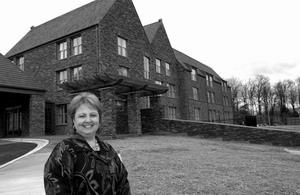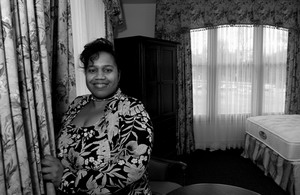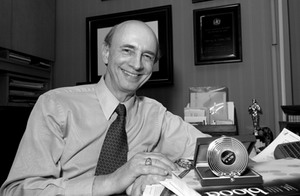Presidential visit
|
|
|
President George W. Bush visited the Clinical Center on January 26 to conduct a discussion of health care alternatives in Masur Auditorium. Greeting the President in the south lobby are Dr. Michael Gottesman, NIH deputy director of intramural research, Dr. John I. Gallin, CC director, Dr. Andrew von Eschenbach, NCI director, Dr. Elias Zerhouni, NIH director and Maryland Gov. Robert L. Ehrlich, Jr.
|
Back to Top
CC helps build a clinical research workforce
Training in the field of clinical research grows more important as the nation strives to develop and build the clinical research workforce–a critical need in the effort to sustain the country's ability to fully explore the ever-expanding opportunities for medical advances.
One effort, the NIH-Duke Training Program in Clinical Research, is helping to fulfill that need. The partnership between the NIH Clinical Center and Duke University Medical Center offers NIH physician-scientists formal academic training in the quantitative and methodological principles of clinical research. Graduates receive a master of health sciences in clinical research, a professional degree awarded by the Duke University School of Medicine. There is also a non-degree option for qualified students who want to pursue specific areas of interest. The Duke program, established in 1986, is one of the nation's first training programs in clinical research. NIH's collaboration with Duke is the first time that the program was made available for long-distance learners. NIH students attend classes via videoconferencing in the Clinical Center.
Since 1998, 105 students from 15 NIH institutes and centers have entered the training program. Of those, 34 have graduated, and 44 remain active in the program.
The first graduate
When Dr. Doug Shaffer headed to Kenya for a year in 2001, he wanted to have a lasting affect on future research and human subjects protection in his role as Director of Clinical Research for the Indiana University-Moi University College of Health Sciences. While in Africa Dr. Shaffer wrote a letter to Dr. John I. Gallin, Clinical Center director. "I see more poverty, death and suffering than at times is bearable, but a day does not go by where I am thankful for the opportunity to be here."
In the same correspondence Shaffer, the first NIH graduate of the NIH-Duke Training Program in Clinical Research, continued, "If my research career ended today, I want you to know that one of the more remarkable benefits with far-reaching impact which the Training Program in Clinical Research may have will come to fruition here in Kenya." Shaffer entered the NIH-Duke program at its inception in 1998. Then a second-year clinical fellow with the NHLBI, he credits the program with his career advancement.
The NIDDK experience
At least one research institute, NIDDK, has developed a mentored clinical research-training program with the NIH-Duke program at its core. For NIDDK investigators Dr. Jeffrey Kopp and Dr. Kristina Rother, the training program is an opportunity to learn how to do better clinical research.
Kopp, intramural staff clinician, Kidney Diseases Section, Metabolic Diseases Branch, conducts basic research on the mechanisms of focal segmental glomerulosclerosis (a scarring kidney disease) and treats patients on related research protocols. His team is studying new ways to use old medications and working to develop new ones for the treatment of focal sclerosis. Although he's been doing clinical research for a while, he wanted to be better informed and trained. "I wanted to improve my clinical research skills. I'm also a mentor and knew the program would help me be a stronger one. The courses give extensive in-depth formal theory and practice instruction. You are taught to ask the right questions, get the right research subjects, how to do research ethically, and obtain a clinically useful result," he said.
Rother is a pediatric endocrinologist in NIDDK's Intramural Islet and Autoimmunity Branch. As a senior staff clinical investigator she's researching ways to help people with Type 1 diabetes. She works with children to keep their insulin-producing cells alive in hopes of giving the children healthier, longer lives. Her basic research training was solid with regard to laboratory science, but she did not have much experience in applied clinical research. "Like many things in life, as a self-taught person you're proud of your accomplishments but you do not have a firm basis. The NIH-Duke program makes you think in a wider horizon by teaching new ways of achieving your goals or finding out what you need to know about a specific condition. You learn about many alternative approaches," said Rother. She referenced the consent to research form. "You typically don't have the luxury of discussing in depth practical, ethical, philosophical and other aspects of the consent form and process. But this training program makes you think—what about kids, prisoners, soldiers—you learn about all the considerations."
The first clinical research curriculum certificate recipient
Those who know Dr. Linda Griffith immediately recognize her motivation and drive. She is a medical officer in the Division of Allergy, Immunology and Transplantation (DAIT) of extramural NIAID. Griffith, the first recipient of the NIH clinical research curriculum certificate (see related story), worked with patients as a clinical fellow at the Clinical Center . She believes this was excellent preparation for her new job in DAIT but is challenged by the complexity of the multi-center studies for autoimmune diseases. She had taken each of the core curriculum courses in clinical research training offered at the Clinical Center by the time she applied to the NIH-Duke Training Program in Clinical Research.
"When I came to the NIH-Duke program it was a natural progression in my quest to acquire a firm foundation in basic principles and to complement the practical experience of my daily work in the management of clinical trials," said Griffith . "The focus of the first part of the curriculum in the NIH-Duke program is on design of clinical trials and statistical analysis, and I am finding this to be of tremendous practical value. My goal is an understanding of the basic concepts, and language of statistics as applied to clinical trials, which is now an important part of my daily work."
Griffith believes the NIH-Duke program holds value to both intramural and extramural scientists. "One of the greatest challenges in my present work is the complexity of the entire process. Imagine a single phase I or phase II study at the Clinical Center (intramural) as a single train moving along a single track. Managing a multi-center study (extramural) is like trying to move multiple trains along multiple tracks in a coordinated manner, and toward a common goal. Both types of endeavors require the kind of knowledge available in the NIH-Duke program."
The NIH-Duke Training Program in Clinical Research enables clinical investigators to conduct state-of-the-art clinical research in the 21st century. That, according to Dr. Louis Simchowitz, director, Office of Fellow Recruitment and Career Development, Division of Intramural Research, NIDDK, is the overall value of the program. "The knowledge gained from the didactic coursework and the clinical research project are invaluable in developing the credentials of the next generation of physician-scientists in medical schools and academic health centers. The program is emblematic of the future training and career develop-ment pathway for those who will lead the way in cutting-edge translational and patient-oriented research."
The NIH-Duke Training Program in Clinical Research academic year begins in late August. Applications for admission are accepted from November through the end of February. For more information call 301-496-9425 or visit http://clinicalcenter.nih.gov/researchers/training/duke.shtml.
– Dianne Needham
Back to Top
CC sponsors Clinical Research Curriculum Certificate Program

|
NIAID's Dr. Linda Griffith receives the clinical research curriculum certificate from Dr. Frederick Ognibene (Left), director, Office of Clinical Research Training and Medical Education, Clinical Center, and Dr. John Gallin, CC director.
|
The Clinical Center is home to a flourishing clinical research training enterprise. A number of education courses are offered through the Clinical Center 's Office of Clinical Research Training and Medical Education. Now, a Clinical Research Curriculum Certificate is being offered to those individuals engaged in, or intending to become engaged in, clinical or translational research including clinical fellows, senior physicians, staff clinicians, investigators, dentists, and allied health care professionals. The Clinical Center will issue a certificate to those success-fully completing the required components of the Clinical Research Curriculum.
"To the best of our knowledge, there is no formal mechanism elsewhere, short of obtaining a masters degree in clinical research, where all of the core components are taught," said Dr. Frederick P. Ognibene, director, Office of Clinical Research Training and Medical Education, Clinical Center .
To satisfy the four mandatory certificate requirements of the Clinical Research Curriculum Certificate Program, individuals must successfully complete the course work in principles and practices of clinical research and the ethical and regulatory aspects of human subjects' research. Additionally, they must have had a meaningful and productive experience and working knowledge of research protocol development, including a practical understanding of institutional review boards. Supplemental or elective components in the Curriculum Certificate Program include the Principles of Clinical Pharmacology course, successful completion of a Foundation for Advanced Education in the Sciences (FAES) course in statistics or epidemiology and completion of an NIH institute – or center-based program in clinical research.
The Clinical Research Curriculum Certificate Program is proposed as an elective, not mandatory, curriculum for clinical fellows; however, all are encouraged to complete the program and obtain a certificate. Completion of all the mandatory components will lead to a certificate. If the mandatory components, plus one or more of the elective components are completed, then a certificate will be awarded "with commendation."
The certificate program is important to clinical researchers in training. "Certificate recipients can take the body of knowledge that they received through the core course work and their certificates with them as they pursue their careers, either at NIH or elsewhere, " said Clinical Center Director and NIH Associate Director for Clinical Research, Dr. John I. Gallin. "Having mastered skills as a clinical researcher is important for future careers. This is a very encouraging time in academic medicine, especially in the context of the NIH Roadmap initiative—re-engineering the clinical research enterprise—which addresses the commitment that NIH has given to the revitalization of clinical research in this country."
For more information on the Clinical Research Curriculum Certificate Program, call the Clinical Center 's Office of Clinical Research Training and Medical Education at 301-496-9425 or visit its website at: http://intranet.cc.nih.gov/clinicalresearchtraining/. Click on Clinical Research Curriculum Certificate.
Back to Top
CFC campaign
|
|
Amy Garner-Obrien, office of the director, staffs a CFC sign-up table near the second-floor cafeteria to encourage employees to contribute to organizations supporting tsunami relief or other charitable causes. Fred Manuel, office of facilities management, signs a pledge.
|
Back to Top
Finishing touches under way at family lodge

|
Jan Weymouth is executive director of the Edmond J. Safra Family Lodge at NIH. It's situated near the intersection of Old Georgetown Road and Center Drive, on the lawn adjacent to the Mary Woodard Lasker Center—just a short walk to the NIH Clinical Center.
|
Finishing touches are in progress at the new, soon-to-open Edmond J. Safra Family Lodge at NIH. It's a major project of the Foundation for the National Institutes of Health and represents the culmination of a dream that Clinical Center employees have worked toward for 10 years.
Contributions totaling $5 million from The Edmond J. Safra Philanthropic Foundation have helped fund the Family Lodge. Contributors also include the Merck Company foundation, the Bristol-Myers Squibb Foundation, GlaxoSmithKline, and The Harry and Jeanette Weinberg Foundation, along with other corporations, foundations and individuals.
Additional funding from the Safra Foundation endows design and construction of the healing garden. Mrs. Safra named this garden in memory of her son and grandson. Both the Lodge and the gardens will open this spring.
"The facility will provide a retreat and sanctuary for the families and caregivers of patients at the NIH Clinical Center." —Jan Weymouth
|

|
A window seat in the center hall overlooks what eventually will be a "healing garden." Mrs. Safra endowed the garden in memory of her child and grandchild. The cozy seating area is one of many throughout the Lodge. Pictured are Margo Bradford, operations manager, and Stephanie Turner, administrative officer.
|

|
At the Family Lodge's front desk are Margo Bradford (left), and Ellen Williams, manager of guest relations.
|

|
Hanging drapes in the Fellowship Hall are Vince Schwartz (on ladder) and Sean Betheas. The hall features a player piano that will fill the lower level of the Lodge with music and encourage guests to gather in the Fellowship Hall.
|
|
|

|
Dilcia Stephens-Medley, program support specialist, adjusts drapes in one of the 34 rooms for Lodge guests. Guests also have access to a business center that supports telecommuting.
|

|
Patients' families can take advantage of the spacious, well-equipped kitchen with an adjacent breakfast room (foreground) and informal den (rear). Looking over newly arrived inventory are Margo Bradford and Stephanie Turner.
|

|
The Lodge's dining room—like the rest of the facility—features wallpaper, woodworking and other details in the style of William Morris, a designer and craftsman whose work was popular in England around 1900.
|
|
Back to Top
Alter receives Inserm Prix Etranger

|
Dr. Harvey Alter displays his medal from Inserm , France 's National Institute for Health and Medical Research.
|
The Clinical Center's Dr. Harvey J. Alter became the first recipient of the Prix Etranger, awarded by France 's National Institute for Health and Medical Research (Inserm) at a ceremony in Paris December 6.
He received the award for his achievements in enhancing the safety of blood transfusions. Like NIH, Inserm supports and promotes research dedicated to improving
the public health and ensuring that patients benefit rapidly from the latest research findings.
"It is a great honor for me to receive this award," said Alter. "NIH and Inserm are sister institutions whose parallel goals are translating scientific discovery directly to patient care. That my research has been selected as worthy of recognition by an organization as prestigious as Inserm is indeed humbling."
Each year, Inserm awards prizes to several French scientists who have made outstanding contributions in basic and applied research. In 2004, the institute established the first international prize—the Prix Etranger —to pay homage to a foreign scientist, in recognition of the role of international collaboration in research progress. The award honored Alter for his work in reducing the risk of post-transfusion hepatitis and the discovery of the hepatitis C virus.
"Dr. Alter's longstanding commitment to public health and his significant contributions to clinical research and transfusion medicine have resulted in dramatic improvements in the safety of the blood supply in the United States and the world," said Dr. Elias A. Zerhouni, NIH director. "The success of the NIH rests squarely on the shoulders of creative clinical investigators like Dr. Alter who have dedicated their careers and lives to preserving and enhancing the public health."
"He is a model for the clinical scientist," said Dr. John I. Gallin, CC director. "He has been a leader in the effort to improve blood safety, and his investigations have been instrumental in the virtual elimination of transfusion-associated hepatitis in the United States ."
The Prix Etranger is the most recent of many honors and awards conferred on Alter, among them the prestigious Albert Lasker Medical Research Award (2002) and the International Society of Blood Transfusion Presidential Award (2000). Alter also holds the distinction of being the first Clinical Center scientist elected to both the National Academy of Sciences and the Institute of Medicine . This coming July, he will receive the American Association of Clinical Chemistry's 2005 Lectureship Award, the highest honor that organization bestows.
Dr. Alter is chief of the infectious diseases section and associate director of research in the Department of Transfusion Medicine. A native of New York City , he earned his MD at the University of Rochester . He came to the NIH Clinical Center as a senior investigator in 1969.
Early in his career, Alter co-discovered the Australia antigen, a key to detecting the hepatitis B virus. Later, he spearheaded a project at the Clinical Center that created a storehouse of blood samples used to uncover the causes and reduce the risk of transfusion-associated hepatitis. Because of his work, the U.S. instituted blood and donor screening programs that have served to increase the safety of the blood supply.
Alter used this repository of clinically linked blood samples to identify another puzzling clinical problem. Most transfusion-related hepatitis was found to be due to a virus different from the two then-known hepatitis agents, A and B. Dr. Alter called this new form of hepatitis non-A, non-B hepatitis and subsequently proved through transmission studies in chimpanzees that it was due to a new agent. This eventually led to the discovery of the hepatitis C virus.
–Marian Segal
Back to Top
Tsunami ceremony
|
|
Chaplain Jean Hankins of the Clinical Center 's Spiritual Ministry Department lights a candle at one of two ceremonies in the 14th Floor chapel last month remembering those who died in the tsunamis in Southeast Asia.
|
Back to Top
Clinical Center website wins 'Best of Show' award
The "NIH Clinical Center Website Redesign: Homepage and Top-Tier Pages" has been selected by the Society for Technical Communications (STC), Washington, D.C., Chapter for two awards in the society's annual communication competition. The Clinical Center website competed in the Online Communication category and captured a Distinguished Award and Best of Show Award. There were 84 entries overall with 17 entries in the Online category. In this group, three entries received Distinguished (first), five Excellent (second) and six Merit (third).
Receiving the awards qualifies the Clinical Center entry for automatic submission to STC's international competition. Results of that competition will be announced in March. Washington 's STC chapter awards will be presented at the local chapter awards luncheon in February. Both awards will be displayed at the international competition at the Society's 52nd Annual Conference to be held in Seattle in May.
The Clinical Center 's website was redone in 2004. A new design and information architecture was applied to the site's home and second- and third-level pages. Usability testing with impartial users was used to guide the final look and content structure. The society's chapter-level judges' comments assessed both the qualitative and quantitative aspects of the redesigned website.
"I was extremely impressed with this website," said one judge, "both with the design and the amount of usability testing that went into it. The newly designed site is very clean and easy to use. This site is very inviting, and I felt encouraged to browse around to see what was available. The supporting data really emphasized just how much effort and thought went into how your users would access information." Another commented, "The writing is consistent throughout the site. It does not come across as scientific or pedantic. Users are encouraged to explore and to use the site as a portal to exploration. The reader-centered approach makes a favorable impression of the Clinical Center ."
The web team consisted of Dianne Needham and Colleen Henrichsen, Clinical Center Communications; Sue Teigen, Ahana Roy, Charles Shaw and Steve O'Krepky, Constella Group, Inc.; Richard Barnes, CIT; Doug Sur, DNA; and Nicole Fall, Technical Quality Management.
STC is an organization dedicated to advancing the arts and sciences of technical communication.
–Dianne Needham
Back to Top
Gingerbread houses
|
|
Members of the Nursing Department created gingerbread houses as part of their holiday celebration this year. They took on a variety of forms, including castles, country mansions and beach houses. One even included a snowman receiving a blood transfusion. The gingerbread houses were set up in the CRC medical board room where staff and patients could view them and vote for their favorite. The houses were then transferred to the Children's Inn where they resided throughout the holidays. Ann Marie Matlock and Julie Kohn spearhead the effort. Pictured are two young patients viewing the first-prize winner, a castle that included a miniature city inside. It was created by the 10th floor outpatient unit. Builders included Babbie Babilonia-Ayukawa, Leanne Ayres, Marc Leone and Craig Terret.
|
Back to Top
Joint orientation
|
Clinical Center's Hospitality staff and members of the security guard force, a part of the NIH Police, are working together to welcome patients and visitors and to help them find their way around the new Hatfield Clinical Research Center. The combined staffs recently attended a joint session that included tours of the new hospital and customer service training.
|

|
Denise Ford, chief, Hospitality Services (left) begins a tour of the facility for members of the NIH Police, including (from left) Major Patricia Haynes, Atem Mbecha, Emmanuel Ndumu and George Doe.
|
|
Back to Top
| |
|
February Grand Rounds
12:00 noon – 1:00 pm, Lipsett Amphitheater
|
| February 2 |
|
Ethics Rounds: When a Patient Requests To Alter His/Her Records, What Is the Appropriate Response?
George Annas, J.D., M.P.H., Chair, Department of Health Law, Bioethics and Human Rights, Boston University School of Public Health
Professor of Socio-Medical Sciences and Community Medicine
Boston University School of Medicine
Lecture can be accessed on the NIH videocast at http://videocast.nih.gov
|
| February 9 |
|
Contemporary Clinical Medicine: Great Teachers
An Internist Encounters Addiction: Heroin, Alcohol and HIV Infection in a 42-Year-Old Man with Abdominal Pain
Jeffrey Samet, M.D., M.A., M.P.H., Professor of Medicine and Public Health
Chief, General Internal Medicine, Boston University School of Medicine,
Boston Medical Center
Lecture can be accessed on the NIH videocast at http://videocast.nih.gov
|
| February 16 |
|
Ovarian Cancer in the Age of Proteomics
Elise Kohn, M.D., Senior Investigator and Section Head, Molecular Signaling Section, Laboratory of Pathology, National Cancer Institute
Molecular Profiling in Breast Cancer: Challenges for the Clinician
Jo Anne Zujewski, M.D., Head, Breast Cancer Therapeutics, Clinical Investigations Branch, Cancer Therapy and Evaluation Program,
National Cancer Institute
|
| February 23 |
|
Therapeutic Misassignment: A Pitfall in the Design of Randomized Trials of Current Practice
Charles Natanson, M.D., Senior Investigator, Critical Care Medicine Department, National Institutes of Health Clinical Center
Magic Matches: Unrelated-Donor Transplants Facilitated by the National Marrow Donor Program
Susan Leitman, M.D., Chief, Blood Services Section, Department of Transfusion Medicine, National Institutes of Health Clinical Center
Visit the Clinical Center Grand Rounds Website at http://www.cc.nih.gov/about/news/grcurrent.shtml
|
Back to Top
|


 The information on this page is archived and provided for reference purposes only.
The information on this page is archived and provided for reference purposes only.